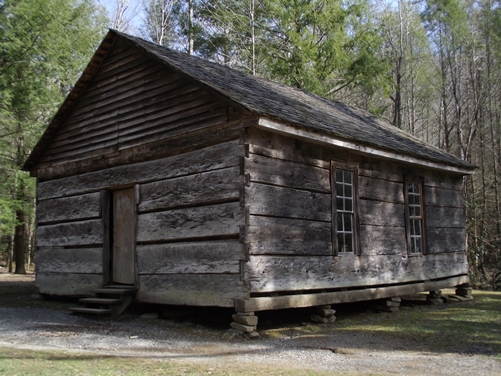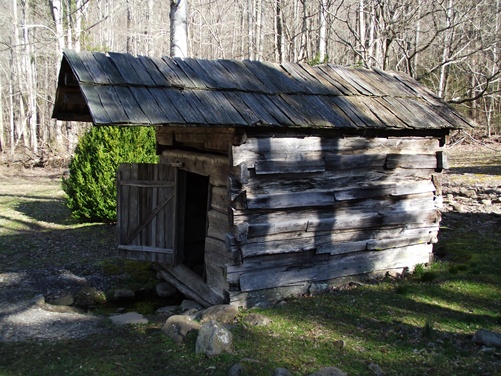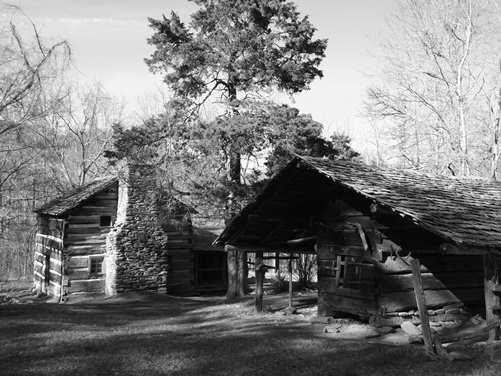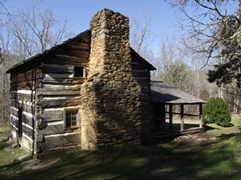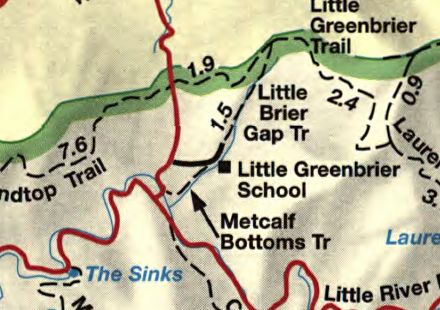
Little Brier Gap Trail Highlights
- Trail Features
History, Walker Sisters Place
- Trail Location
Metcalf Bottoms
- Roundtrip Length
2.6 Miles
- Elevation Gain (total)
285 Feet
- Elevation Gain (per mile)
219 Feet
- Trail Difficulty
3.17
Easy
This easy hike is 2.6 miles roundtrip and includes 285 feet of elevation gain.
Little Brier Gap Trail Description
The Little Brier Gap Trailhead is located in the heart of an old mountain community known as Little Greenbrier. Once simply known as "Greenbrier," the "Little" moniker was eventually added to its name in order to distinguish it from the larger Greenbrier community located along the Middle Fork of the Little Pigeon River, just north of Mt. LeConte.
Arriving in the late 1830s, Arthur "Brice" McFalls and Alexander McKenzie were among the earliest documented settlers in the Little Greenbrier area. Legend has it that McFalls built a cabin in the 1840s, which was purportedly reassembled in the late 1870s by John Walker, father of the Walker Sisters, as the "kitchen" half of the Walker Cabin.
In 1882 Walker also helped to build the Little Greenbrier School. Students throughout the Little River Valley attended the school, including some from the Meigs Mountain community which was located more than four miles away. The schoolhouse was also used for church services by a local Primitive Baptist congregation, which established the nearby cemetery. The last classes in the 20 x 30 foot schoolhouse were held in 1935. Today the Little Greenbrier Schoolhouse is on the National Register of Historic Places, and is located at the Little Brier Gap Trailhead.
Little Greenbrier Schoolhouse
From the trailhead, and for much of its length up to the Walker Sisters Place, the path follows a small stream known as Little Brier Branch. The wide path, once an old road, gradually climbs a hollow along the southwestern flank of Cove Mountain.
Roughly six-tenths of a mile from the schoolhouse the trail crosses over a footbridge. Then, at just over 1.1 miles, hikers will reach the side trail that leads to the Walker Sisters Place. From this junction the homestead is only two-tenths of a mile away.
Little Greenbrier achieved a degree of national fame as a result of the Walker Sisters. The five spinster sisters who lived here refused to sell their 123-acre farm to the national park, and were able to maintain their traditional mountain life into the 1960s.
John Walker, a Union Army veteran, and his wife, Margaret, moved onto the homestead in 1870. Over the years, as his family grew to eleven children, John expanded the cabin and made several improvements to the farm. At one point the homestead consisted of several outbuildings, including a barn, blacksmith shop, applehouse, springhouse, smokehouse, pig pen, corn crib and a small tub mill. Today, only the cabin, springhouse and corn crib survive at the site.
Walker Sisters Spring House
In 1909 Walker deeded the land to his youngest son, Giles, and five of his daughters; Margaret (1870-1962), Martha (1877-1951), Nancy (1880-1931), Louisa (1882-1964) and Hettie (1889-1947). By this time the other children were already married and had moved away. After John died in 1921 the farm was passed to the five daughters (later in that same year Giles would deed his share of the land over to his sisters).
Walker Sisters Place
While the surrounding mountain communities slowly began to modernize after World War I, the Walker Sisters continued to pursue their traditional way of life, which emphasized independence and self-reliance. The five sisters would continue to raise sheep, grow crops, plow their own fields and make their own clothes from the wool and cotton they raised.
Change, however, would be forced upon the Walker Sisters. In the 1930s the Great Smoky Mountains Park Commission, responsible for purchasing property for the new national park, tried to persuade the sisters to sell their farm. Realizing that the park was wading into a public relations minefield, GSMNP Superintendent Ross Eakin sent a memorandum to the Director of the National Park Service on Nov. 18, 1939, stating; "These old women are 'rooted to the soil.' We have always understood they were to be permitted to spend the rest of their lives on their property. . . . If they were ejected from the park we should be subject to severe criticism, and in my opinion, justly so."
Finally, in late 1940, faced with a condemnation suit, the Walker Sisters accepted $4,750 for their land, provided they were "allowed to reserve a life estate and the use of the land for and during the life of the five sisters." On January 22, 1941, ownership of the Walker Sisters' land finally passed to the national park. A local legend claims that President Franklin Roosevelt paid a visit to the sisters and convinced them to sell the farm to the new park. Although Roosevelt was in the area to dedicate the national park in 1940, there's no evidence of him having visited the sisters.
In 1946 the Saturday Evening Post published a feature article that highlighted the Walker Sisters traditional lifestyle, which subsequently led to a steady stream of tourists to their farm.
By 1953 only two of the sisters were alive. The following is a letter that was written by Margaret and Louisa to the superintendent of the park (Edward Hummel):
To the Supertendant of the Great Smokie Mountain National Park
Dear Sir
I have a request to you Will you please have the Sign a bout the Walker Sisters taken down the one on High Way 73 especilay the reason I am asking this there is just 2 of the sisters lives at the old House place one is 70 years of age the other is 82 years of age and we can't receive so many visitors We are not able to do our Work and receive so many visitors, and can't make sovioners to sell like we once did and people will be expecting us to have them, last year we had so many people it kept us buisy from Sun up till sun down besides our own work We haven't bin feling very well this winter can't do much at our best. I write poems to sell but cant write very well I use to write of winter but I havent bin able to do much for the 2 last ones My Brother is in the Hospital and cant stay with us much We mis his help We have a Grant Nephew and his wife with us now There was 5 of us living here when we began to receive visitors and we enjoyed meeting so many nice people from different places from every state in the union and many out side, some of them came every time they came to the park, there was more of us and we were more able to care for things, they bought things from us and made it easier to have spinding money. they buy things yet if we was abel to fix them but it is to confining on us now with no more help if we get to feeling better or get till we can receive them a gain we may want to receive them a gain but we want to rest a while it is to much work for us now. Come visit us if you have time.
Very Respectively
The Walker Sisters
Margaret and Louisa
The National Park Service assumed control of the land when Louisa, the last of the Walker Sisters, died in 1964. The National Park Service restored the cabin in 1976, and in that same year, all three surviving structures on the site were placed on the National Register of Historic Places.
Little Brier Gap Trail Map

Little Brier Gap Trail Elevation Profile

Directions to Trailhead:
The hike to the Walker Sisters Place in the Great Smoky Mountains begins from the Little Brier Gap Trailhead. To reach the trailhead from the Townsend "Y" intersection near Cades Cove, drive 7.4 miles to reach the Metcalf Bottoms Picnic Area. Turn left into the picnic area and drive across the one-lane bridge. At 0.4 miles from Little River Road, turn right onto Little Greenbrier Road. The parking area for the Little Brier Gap Trailhead is less than a half-mile up the narrow gravel road, and is next to the historic Little Greenbrier School.
From the Sugarlands Visitor Center near Gatlinburg you'll drive 10 miles to reach the Metcalf Bottoms Picnic Area.
Please note that Little Greenbrier Road is closed from late December until early March each year. If you wish to hike the trail during the winter months you'll have two options:
1) Begin your hike from the small parking area located on Wear Gap Road (Lyon Springs Road), near the junction with Little Greenbrier Road. This will add a hike of 0.45-miles and a climb of 110 feet to reach the trailhead.
2) Begin your hike from Metcalf Bottoms and hike the Metcalf Bottoms Trail up to the Little Greenbrier School. This trail is 0.7 miles in length and climbs roughly 120 feet.
